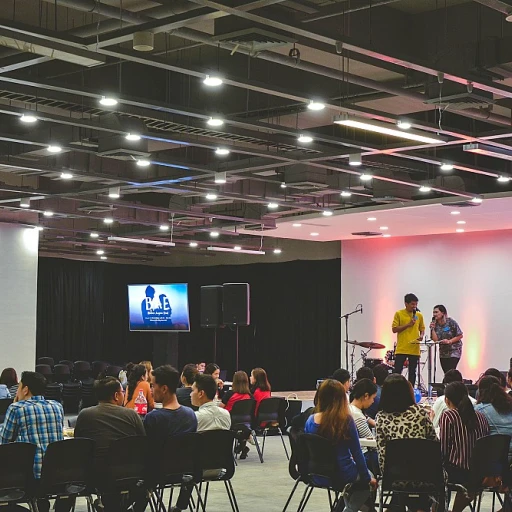
Understanding the Evolving Workforce
Adapting to a Shifting Workforce Landscape
The future of work is rapidly evolving, with significant implications for training and development. As businesses navigate these changes, understanding the dynamics of the evolving workforce becomes crucial. Companies are witnessing a transformation in employee demographics, work preferences, and technological adeptness, all of which influence training strategies.
Today's employees come from diverse backgrounds, bringing varied skills and learning experiences to the table. This diversity presents both opportunities and challenges for training programs. L&D professionals must tailor their approaches to meet different learning styles and skill levels, ensuring that training content is relevant and engaging for all participants.
Moreover, as the workforce becomes more digital-savvy, there's an increased demand for training programs that incorporate technology effectively. The integration of digital tools can enhance learning development by providing interactive and immersive experiences. However, it also requires careful planning to avoid overwhelming learners with excessive task difficulty or undesirable difficulties.
To address these challenges, organizations need to focus on flexible training development strategies that can adapt to the changing needs of employees. This includes offering personalized learning paths and providing timely feedback to improve performance and skill acquisition. By doing so, companies can ensure that their teams are equipped with the necessary skills to thrive in the long term.
For more insights on preparing for tomorrow's careers, the essential role of reskilling is explored in greater detail here.
Technological Advancements and Training
Embracing Technological Advances in Training Programs
Technological advancements are reshaping the landscape of employee training and development, creating both opportunities and challenges for learning and development professionals. As businesses strive to equip their employees with the necessary skills, incorporating innovative technology into training programs becomes essential. It's not just about convenience but about enhancing the quality and effectiveness of learning experiences overall. Technology can offer adaptable learning experiences that cater to diverse levels of skill and knowledge among participants. By using tools like AI-driven platforms and virtual reality, training sessions can be more interactive, providing learners the chance to practice complex tasks and, ultimately, improve performance. This approach allows learners to engage actively and receive immediate feedback, a crucial component in addressing training difficulty levels and helping learners develop a more comprehensive understanding of the material. Despite the promise of technology, challenges persist. L&D professionals often face difficulty in identifying which technologies best align with the company's goals and ensuring that all employees can effectively utilize these tools. There is also the issue of integrating cutting-edge technology without overwhelming the team or diverting from core training objectives. A strategy blending technology with traditional methods can often lead to a more balanced learning development approach. As organizations prepare for tomorrow’s careers, the role of technology in reskilling and upskilling cannot be underestimated. Embracing this digital transformation in training not only improves skill acquisition but also empowers employees at all levels to take ownership of their personal and professional growth. For further insights, a comprehensive guide to preparing for tomorrow's careers underscores the essential role of reskilling, providing a roadmap for how technology can support this process effectively. Thus, the integration of technological advancements in training development is vital for keeping pace with an ever-evolving work environment. It helps bridge the gap between current skill levels and future demands, equipping teams to navigate new challenges with confidence and competence.Bridging the Skills Gap
Closing the Skills Divide
The workplace is evolving rapidly, necessitating continuous skills development among employees. One of the primary challenges facing businesses today is how to effectively bridge the skills gap. Despite robust training programs and workshops, many organizations still struggle to equip their workforce with the necessary capabilities. The transition from traditional training methods towards more dynamic and responsive learning experiences is imperative. Employees now require a blend of hard and soft skills to navigate complex tasks and adjust to evolving job roles. Integrating a mix of real-world practice with developmental programs designed to nurture both technical and interpersonal competencies is essential. Organizations often encounter several difficulty levels when implementing employee training programs. Tailoring the content to cater to specific task difficulty and providing adequate resources can help alleviate these challenges. L&D professionals should focus on utilizing best practices to mitigate training challenges, ensuring active participation and engagement during training sessions. It's crucial to understand that learning should be perceived as a continual journey rather than a one-time task. Implementing long term strategies and encouraging feedback loops can significantly enhance the effectiveness of training efforts. As participants engage in training programs that focus on desirable difficulties, they can better prepare for real-world applications. A journal experimental approach to training development might reveal further insights into the effectiveness of various strategies. To truly close the skills gap, organizations must invest time and effort into customizing their training programs, fostering an environment of continuous learning development. For more insights on advancing skills across various sectors, including a closer look at the pharmaceutical industry, explore our detailed analysis on advancing skills and knowledge.Personalization in Training
Tailoring Learning Paths for Individual Growth
In the landscape of employee training, the emphasis on personalization is becoming increasingly critical. Considering the significant variation in skill levels and learning preferences among employees, a one-size-fits-all approach is no longer viable. Personalization in training aligns educational content with the unique needs of each learner, facilitating targeted development. This approach ensures that participants engage with material that directly pertains to their job roles and skill requirements. By integrating adaptable training sessions, facilitators can cater to varying difficulty levels, thus accommodating both beginners and advanced learners. The concept of "desirable difficulties" comes into play here, introducing challenges that optimally stretch a learner's capabilities, promoting better long-term retention. Incorporating different levels of task difficulty not only enhances the learning experience but also prepares employees to tackle real-world challenges with confidence. Moreover, providing timely feedback is essential to the process. Constructive feedback helps learners identify areas for improvement, driving their personal development. It also empowers L&D professionals to adjust training programs dynamically based on participants' progress and needs. Employee training should ultimately aim at fostering a continuous learning culture. By recognizing and adapting to the diverse learning modes and preferences within a team, organizations can significantly boost overall performance and facilitate more effective training development programs.Overcoming Resistance to Change
Encouraging Adaptation and Embracing New Learning Experiences
Overcoming resistance to change remains one of the notable challenges in employee training. Often, the fear of the unknown and uncertainty regarding new tasks can hold learners back, impacting performance and overall success. To address this, it's vital to focus on creating a culture that values continuous learning and adaptability. Encouraging employees to embrace new learning experiences and seeing them as necessary steps in their professional development can help ease the process.- Communication and Transparency: It's important to clearly communicate the goals and benefits of any new training program or development initiative. Employees should understand how their involvement will contribute to their own career progression and how crucial their role is in the team's success.
- Assessing Training Difficulty Levels: Understanding different difficulty levels within training programs can help make transitions smoother. Employing concepts like desirable difficulties helps ensure that tasks challenge employees just enough to enhance skills without causing overwhelming frustration.
- Involving Employees in Training Development: Having employees participate in the development of training content can increase buy-in and reduce resistance. By incorporating their feedback and experience, training sessions become more relevant and engaging.
- Ongoing Support and Feedback: Implementing mechanisms for feedback allows L&D professionals to adjust training programs based on real-time insights. Employees are more likely to engage with, and enjoy, learning sessions if they feel their feedback is valued.












